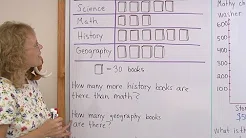assignment_returnWorksheet:
Analyze Patterns And Relationships
Standard(s): 5.OA.B.3
Which set of numbers completes the function table?

4, 5, 11, 15
3, 6, 24, 36
3, 6, 32, 48
11, 12, 18, 112
Standard: 5.OA.B.3
Domain: Operations & Algebraic Thinking
Theme: Analyze patterns and relationships
Description: Generate two numerical patterns using two given rules. Identify apparent relationships between corresponding terms. Form ordered pairs consisting of corresponding terms from the two patterns, and graph the ordered pairs on a coordinate plane. For example, given the rule "Add 3" and the starting number 0, and given the rule "Add 6" and the starting number 0, generate terms in the resulting sequences, and observe that the terms in one sequence are twice the corresponding terms in the other sequence. Explain informally why this is so.
Which set of numbers completes the function table?

2, 5, 15, 20
1, 4, 7, 11
30, 105, 180, 280
0, 3, 6, 10
Standard: 5.OA.B.3
Domain: Operations & Algebraic Thinking
Theme: Analyze patterns and relationships
Description: Generate two numerical patterns using two given rules. Identify apparent relationships between corresponding terms. Form ordered pairs consisting of corresponding terms from the two patterns, and graph the ordered pairs on a coordinate plane. For example, given the rule "Add 3" and the starting number 0, and given the rule "Add 6" and the starting number 0, generate terms in the resulting sequences, and observe that the terms in one sequence are twice the corresponding terms in the other sequence. Explain informally why this is so.
Consider the following number sequence:
x: begin at 4, multiply by 2
Which would result in a relationship in which y is always half as much as x?
y: begin at 4, multiply by 4
y: begin at 4, multiply by ½
y: begin at 2, multiply by 1
y: begin at 2, multiply by 2
Standard: 5.OA.B.3
Domain: Operations & Algebraic Thinking
Theme: Analyze patterns and relationships
Description: Generate two numerical patterns using two given rules. Identify apparent relationships between corresponding terms. Form ordered pairs consisting of corresponding terms from the two patterns, and graph the ordered pairs on a coordinate plane. For example, given the rule "Add 3" and the starting number 0, and given the rule "Add 6" and the starting number 0, generate terms in the resulting sequences, and observe that the terms in one sequence are twice the corresponding terms in the other sequence. Explain informally why this is so.
Consider the following two number sequences:
x: begin at 2, add 3
y: begin at 4, add 6
Which describes the relationship between the number sequences?
The terms in sequence y are two more than the terms in sequence x.
The terms in sequence y are six times the terms in sequence x.
The terms in sequence y are two times the terms in sequence x.
The terms in sequence y are half as much as the terms in sequence x.
Standard: 5.OA.B.3
Domain: Operations & Algebraic Thinking
Theme: Analyze patterns and relationships
Description: Generate two numerical patterns using two given rules. Identify apparent relationships between corresponding terms. Form ordered pairs consisting of corresponding terms from the two patterns, and graph the ordered pairs on a coordinate plane. For example, given the rule "Add 3" and the starting number 0, and given the rule "Add 6" and the starting number 0, generate terms in the resulting sequences, and observe that the terms in one sequence are twice the corresponding terms in the other sequence. Explain informally why this is so.
Which describes the graph of this function plotted on a coordinate grid?

A curving line
A horizontal line
An upward sloping line
A downward sloping line





